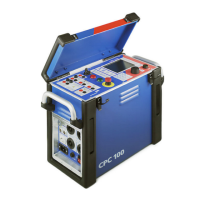CPC 100 V1.41
1 - 8
• When measuring the ratio of voltage and power transformers make sure that
the test voltage is connected to the corresponding primary winding, and the
voltage of the secondary winding is the one that is measured. Accidentally
mixing up the windings can generate life-threatening voltages within the
transformer.
For example: feeding a voltage of 100V/
√3 to the secondary winding of a
voltage transformer that has a ratio of 400000V/
√3 : 100V/√3, induces a
voltage of 400000V/
√3 in the transformer’s primary winding.
• Make sure that when testing a current transformer by feeding a test current
into its primary winding, all secondary windings are shorted. On open
secondary windings, life-threatening voltages can be induced!
DC output to test objects with a high inductance
Use the RWinding (winding resistance) and TRTapCheck (tap changer winding
resistance and on-load tap changer interruption check) test cards only.
As long as the CPC 100 software shows the on-screen message "Switch off in
progress", NEVER connect or disconnect test objects and/or cables.
The message "Switch off in progress" notifies you
that, after CPC 100 was switched off, the
connected external inductance (that is, the test
object) still "feeds" voltage potential back into the
6A DC or 400A DC output.
The existence of this voltage potential at the
6A DC output is also indicated by a lit LED - even
if CPC 100 is switched off.
The CP SA1 (see ”CP SA1” on page 17-14) must be connected to the
CPC 100 V DC input sockets when using the 400A DC output to protect
yourself and CPC 100 from high-voltage hazards.
If a test object with a big inductance was connected to CPC 100, short-out the
test object additionally before disconnecting it from CPC 100.

